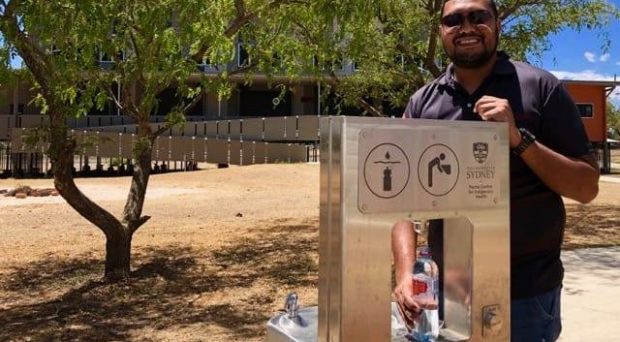
Good oral health is important for overall general health and wellbeing. Good oral health enables a person to eat, speak and socialize without pain or embarrassment. Common dental diseases include dental caries (tooth decay) and gum disease, which are both largely preventable.
Many Australians enjoy good oral health, but for some populations, including Aboriginal Australians, this is not equally shared. Many Aboriginal people, particularly Aboriginal people living in rural and remote communities across Australia experience higher levels and often more severe levels of dental caries. This gap in oral health is due to a range of factors including limited oral health promotion resources and lack of access to oral health services that meet the cultural and social needs of Aboriginal Australians.
Engaging Aboriginal Australians in the design and delivery of health services and health promotion is crucial to providing effective services.
Engaging Aboriginal Australians in the design and delivery of health services and health promotion is crucial to providing effective services. This is because they consider the local needs, knowledge and culture of the community, which means the services are more likely to be used and effective. This approach, known as co-design, has been effective in improving oral health and education outcomes for Aboriginal Australians.
For example, a co-designed oral health promotion program for Aboriginal children in rural and remote communities in NSW, Australia was able to reduce dental caries among children and improve positive oral hygiene behaviors such as brushing with fluoride toothpaste, drinking water and reducing the consumption of sugar-sweetened beverages.
The program involved daily in-school tooth brushing, regular dental health education by a local Aboriginal dental assistant, regular fluoride varnish applied to teeth and installation of refrigerated and filtered water fountains in schools and the wider community. More information on this program can be found in an article in The Conversation.
The co-design process gives Elders, schools and community members the opportunity to advise on the development of evidence-based strategies that can prevent dental caries and how they can be best be implemented in their community. This meant that the strategies were implemented in ways the community identified as suitable and that they were sustainable and well-received, and in turn improved oral health outcomes.

The Partnering to Improve the oral health of Aboriginal and Torres Strait Islander adolescents study (also known as the Indigenous Adolescent Oral Health Partnership [IAOHP] study) will apply the same principles of co-design to develop a holistic oral health promotion program to improve the oral health and social-emotional well-being of Aboriginal adolescents in Queensland, New South Wales and Victoria, Australia. The IAOHP study registration can be found here.
The IAOHP study will involve a peer-led process to co-design a program that aims to encourage the uptake of five strategies that can improve oral health among Aboriginal adolescents aged 10–19 years. These strategies include 1) increasing fluoride treatment, 2) increasing tooth brushing with fluoride toothpaste, 3) increasing consumption of water, 4) improving nutrition and 5) enhancing social and emotional well-being.
As part of the peer-led process, a working group of Aboriginal adolescents from various communities across Queensland, New South Wales and Victoria, Australia will be recruited to learn about co-design and how it can be applied in research to improve health outcomes for Aboriginal people (Phase 1). They will use these skills to run yarning groups* in their communities with their peers to identify how these five strategies can be best implemented in their local community to reach Aboriginal adolescents effectively.
For example, this might include installing refrigerated and filtered water fountains in schools and implementing water-only policies at local schools and community groups to increase consumption of water, or in-school tooth brushing programs to increase tooth brushing with fluoride toothpaste.
The IAHOP study is a new approach to working with Aboriginal adolescents to co-design oral health promotion with and for this group rather than imposing programs that may not be culturally or socially relevant.
The IAOHP study aims to recruit 60 adolescents to participate in the co-designed program from various communities across Queensland, New South Wales and Victoria. A project manager will be assisting the working group to develop and implement these strategies. The strategies will be implemented for a period of 12 months in each community (Phase 2). Phase 3 will involve an evaluation of the IAOHP study to determine the impact of these strategies on the oral health and social and emotional well-being of adolescents who participate in the program.
A primary outcome measure will be changes in oral health status assessed using a caries experience index (dmft/DMFT index), which measures the number of teeth affected by dental caries. Secondary measures will include the satisfaction of participants, self-reported changes in diet and drinking water and sugar-sweetened beverages and changes in quality of life measured using validated questionnaires.
The IAOHP study will begin recruiting the working group in mid-2022 to complete Phase 1 of this study. The IAHOP study is a new approach to working with Aboriginal adolescents to co-design oral health promotion with and for this group rather than imposing programs that may not be culturally or socially relevant.
The IAHOP study aims to develop a ‘toolkit’ for Australian public oral health services and policymakers to engage with adolescents to co-design evidence-based oral health promotion to improve oral health and general health outcomes for Australian adolescents.
*Yarning groups are similar to focus groups however they use a culturally appropriate method of conversation known as yarning.
Comments